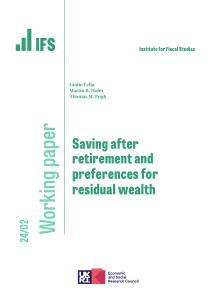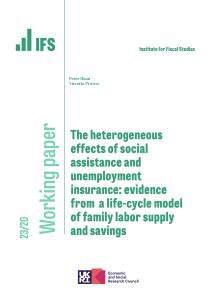Since 2015, people over the age of 55 with defined contribution (DC) pension pots have had full freedom to decide what they want to do with them; no one has to buy an annuity (a guaranteed income for life).
In a new IFS report published today, funded by the IFS Retirement Savings Consortium and the Economic and Social Research Council, we look at how people plan to use these freedoms and what plans they have to access their pension pots.
We find that:
- When asked how they plan to access their pension pots, more than four in ten of those in their 50s and early 60s with defined contribution pension pots answer ‘don’t know’. Not having a plan for how to access pension pots in retirement is even more common among those with low levels of wealth and those who have not used a financial adviser.
- Such large numbers not knowing how they will access their pension is worrying. People find it too difficult to engage with, and plan for, their financial security in retirement even as they approach retirement.
These are important decisions: half of people in their 50s have defined contribution pension pots. As the prevalence and size of average DC pots continue growing, due to automatic enrolment and the decline of traditional defined benefit pensions, future generations will be increasingly reliant on DC schemes for financing their retirement. These decisions will be more consequential for each subsequent generation.
Other findings include:
- Most accessing DC pension plans for the first time withdraw their pot in full. This leads to concerns that people might be spending their retirement resources too quickly. However, even fully withdrawn pension pots typically make up a small fraction of overall resources – on average (at the median), the withdrawn funds account for only 3% of private family wealth.
- There is an important minority of people who make large withdrawals from their pension pots that constitute a large fraction of their total financial resources. For one in six of those who withdrew a DC pot in full, the amount withdrawn was worth at least £20,000 and this amounted to at least a tenth of their overall family wealth. This is the group where making good decisions around accessing their DC pension pot will be particularly important for their living standards through retirement.
- However, for many of those currently approaching retirement, the decisions around accessing DC pots are ‘low-stakes’ because of the relatively low value of the DC pension compared with other resources available to them. Among those with at least some DC pension wealth, it is worth – on average – 12% of wealth once we include the value of housing, the state pension, and other pensions and savings. This compares with large fractions of wealth on average being held in forms that will provide a stream of income or flow of benefits throughout retirement – 24% in the state pension, 19% in defined benefit pensions, and 24% in owner-occupied property.
Heidi Karjalainen, a Research Economist at IFS and an author of the report, said:
‘It can be difficult for individuals to decide how to access savings in a defined contribution pension, and indeed many of those approaching retirement report that they do not know how they will access their pension pots. For many of those currently in their 50s, these are ‘low-stakes’ decisions, as they have significant other retirement resources available to them. But that will change as future generations will rely more heavily on defined contribution pension pots for financing their retirement.
‘Developing how best to support people to make good financial decisions when accessing defined contribution schemes is crucial, so that individuals are protected against adverse outcomes through their retirement.’









